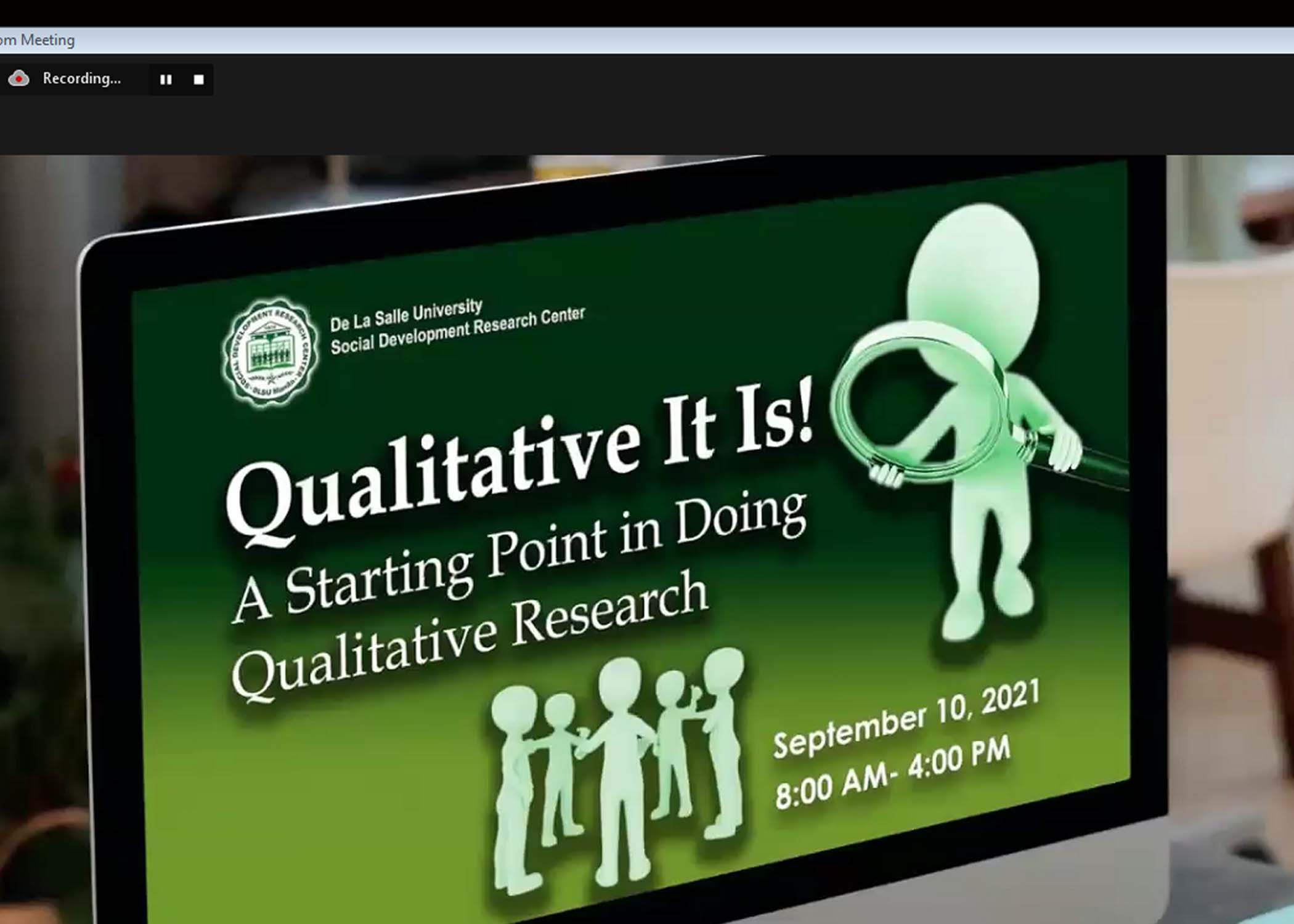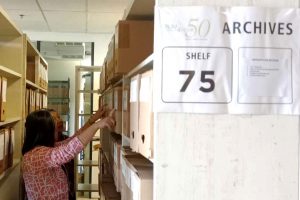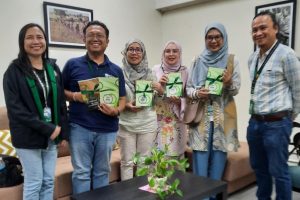The Making and Experience of Meaning: Getting to Know Qualitative Research
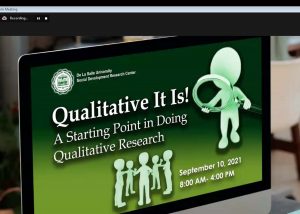 As a researcher, does one do investigations in order to determine patterns and trends? Or is there a motivation to search for more – for something deeper?
As a researcher, does one do investigations in order to determine patterns and trends? Or is there a motivation to search for more – for something deeper?
If the answer is the latter, then: Qualitative is key!
This was the focal point of the “Qualitative It Is! A Starting Point in Doing Qualitative Research” webinar hosted by SDRC on September 10 via Zoom. The webinar was part of a continuing series of online capacity building and training workshops that the Center is offering for interested groups and individuals, to enable them to benefit from “New Knowledge for the New Normal”, and to learn regardless of where their location may be during the pandemic.
Dr. Dennis Erasga, SDRC research fellow and senior faculty of the DLSU Department of Sociology and Behavioral Sciences, began the morning session of the webinar by posing a concept question to participants to determine how best to describe qualitative research. Based on their answers, a majority saw this type of research as being concerned with what happens in “the real world, where the action is,” rather than what is “on the shelves, collecting dust”. He then proceeded to present a definition that matched that of the participants, in Hammersley’s notion (2013) that qualitative research is a form of social inquiry that tends to adopt a flexible and data-driven research design, to use relatively unstructured data, to emphasize the essential role of subjectivity in the research process, to study a small number of naturally occurring cases in detail, and to use verbal rather than statistical forms of analysis.
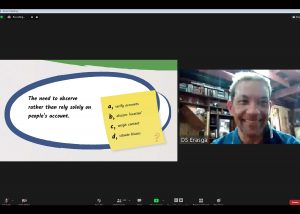 Dr. Erasga continued the discussion by looking into the nature of qualitative research, which exhibits three organic features: A paradigm, or an angle of looking at the subject; an approach, or method of doing the research; and an interpretation, or a quality of sense-making. Particular attention was given to the concept of the angle from which one views the subject, or the “gaze” through which one looks intently and steadily. In this manner, a researcher can better “see” topics that impact people’s lives, issues that are consequential to relationships in society, and situations that challenge the state of things. He emphasized further that the quality of subjective bias, in relation to how one looks at the object being studied, provides an impetus to and guides the entire research process.
Dr. Erasga continued the discussion by looking into the nature of qualitative research, which exhibits three organic features: A paradigm, or an angle of looking at the subject; an approach, or method of doing the research; and an interpretation, or a quality of sense-making. Particular attention was given to the concept of the angle from which one views the subject, or the “gaze” through which one looks intently and steadily. In this manner, a researcher can better “see” topics that impact people’s lives, issues that are consequential to relationships in society, and situations that challenge the state of things. He emphasized further that the quality of subjective bias, in relation to how one looks at the object being studied, provides an impetus to and guides the entire research process.
With regard to the way in which an investigation is conducted, Dr. Erasga pointed out the importance of observation rather than relying solely on informants’ accounts. Such observation involves verifying accounts, discerning informants’ sentiments regarding the issue, weighing context, and situating biases. He also noted that standards should be adhered to when doing the research, in order to prevent the meaning of central concepts from being lost or changed due to quantification. Ultimately, he stressed the importance of recognizing that research exists because humans are by nature a meaning-making and meaning-experiencing species, and by nature create the connections that are subject to social inquiry.
Among the questions raised by participants regarding Dr. Erasga’s presentation were what would be the prescribed number of respondents required in qualitative research, and in an FGD; what to do when a respondent disagrees with the researcher’s interpretation; whether individual interviews or FGDs are more appropriate for deriving data for a phenomenological research; whether unobtrusive observation as a methodology was ethically acceptable; whether bias in conducting a study puts its results at stake; how to reconcile the need to provide authentic interpretations and the desire to uphold objectivity in doing qualitative research; whether year of publication matters in references used; and whether there is a need to incorporate the results of previous studies when presenting the discussion of a study’s results.
At the end of the discussion, participants shared their “Aha Moments” or the new knowledge they were taking away from the session. They shared that the webinar was “Motivating – a breakthrough” and that “Dr. Erasga untangled many ‘obstructions’ and uncertainties on qualitative research”. They especially appreciated the discussion on “understanding subjective bias and how it can affect data gathering” and on how “when a researcher introduces a systematic inaccuracy into sample data, the entire process is skewed toward a given study outcome.”
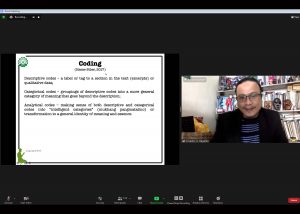 The afternoon session on “Qualitative Data Analysis and Interpretation Using NVIVO” was presented by Dr. Crisanto Regadio, SDRC Research Fellow and Vice Chair of the DLSU Department of Sociology and Behavioral Sciences. Focusing on the methodological characteristics of qualitative research in preparing, exploring, specifying and interpreting the data that has been collected, he framed the first part of his discussion using Hess-Biber’s “Ontological, Epistemological and Methodological Issue: Science or Not”. He engaged participants by eliciting their knowledge and positions on “What is out there to know?” (whether from the Positivist, Interpretative or Critical paradigms of Ontology), “What and how can we know about it?” (from Epistemological study – identifying who the knowledge makers are, and how researchers must translate knowledge to make it accessible to all), “How do we acquire that knowledge?” and “Which precise measure can we use to acquire it?” (selecting a strategy or methodology), and “Who are our participants?” (identifying sources of information).
The afternoon session on “Qualitative Data Analysis and Interpretation Using NVIVO” was presented by Dr. Crisanto Regadio, SDRC Research Fellow and Vice Chair of the DLSU Department of Sociology and Behavioral Sciences. Focusing on the methodological characteristics of qualitative research in preparing, exploring, specifying and interpreting the data that has been collected, he framed the first part of his discussion using Hess-Biber’s “Ontological, Epistemological and Methodological Issue: Science or Not”. He engaged participants by eliciting their knowledge and positions on “What is out there to know?” (whether from the Positivist, Interpretative or Critical paradigms of Ontology), “What and how can we know about it?” (from Epistemological study – identifying who the knowledge makers are, and how researchers must translate knowledge to make it accessible to all), “How do we acquire that knowledge?” and “Which precise measure can we use to acquire it?” (selecting a strategy or methodology), and “Who are our participants?” (identifying sources of information).
Continuing to cite from Hess-Biber, Dr. Regadio expounded on analysis and interpretation, distinguishing the former as “an examination of anything complex in order to determine its essential features” from the latter as “explanation” or “the way something is understood.” He then demonstrated how coding – or assigning meaning to a chunk of text or data – was performed, and introduced participants to the NVIVO software, which he explained could be useful in discovering what the codes are saying.
After the presentation, Dr. Regadio addressed participants’ questions on whether mixed methods can be used in data analysis; who decides when to stop coding a particular text; how to avoid subjectivity in coding given the researcher chooses the codes; whether an external auditor was needed to make coding more authentic; whether NVIVO can be language sensitive, and whether the software can be used for quantitative content analysis.
A total of 111 registered participants attended the event, representing the University of St. La Salle-Bacolod, Capiz State University, St. Louis College-La Union, Polytechnic University of the Philippines, San Juan de Dios Educational Foundation, Inc., University of the Philippines-Diliman, UP-Manila, Cebu Technological University, Korbel Foundation College, Inc.-Koronadal, Lourdes School of Mandaluyong, Amai Pakpak Medical Center – Marawi, Ateneo de Manila University, Bulacan State University, Bataan Peninsula State University, Bicol State College of Applied Science and Technology-Naga, Bicol University-Tabaco, Cavite State University-Naic, Emilio Aguinaldo College-Cavite, Far Eastern University, Isabela State University, Kapitan Eddie T. Reyes Integrated School-Taguig, La Salle Academy-Iligan, Lyceum of the Philippines University-Laguna, Metropolitan Medical Center College, Mindanao State University-Iligan Institute of Technology, Pamantasan ng Lungsod ng Maynila, Saint Pedro Poveda College, St. Louis University-Baghio,St. Martin Cooperative-Bulacan, Sultan Kudarat State University, University of Makati, University of Northern Philippines-Vigan, University of Nueva Caceres, UP-Los Baños, University of Santo Tomas, University of Science and Technology of Southern Philippines, University of the East-Ramon Magsaysay Medical Center, Visayas State University-Leyte, Social Weather Stations, Teleperformance, Department of Education, Department of Energy, Department of Science and Technology-Industrial Technology Development Institute, and DOST-Philippine Institute of Volcanology and Seismology.


